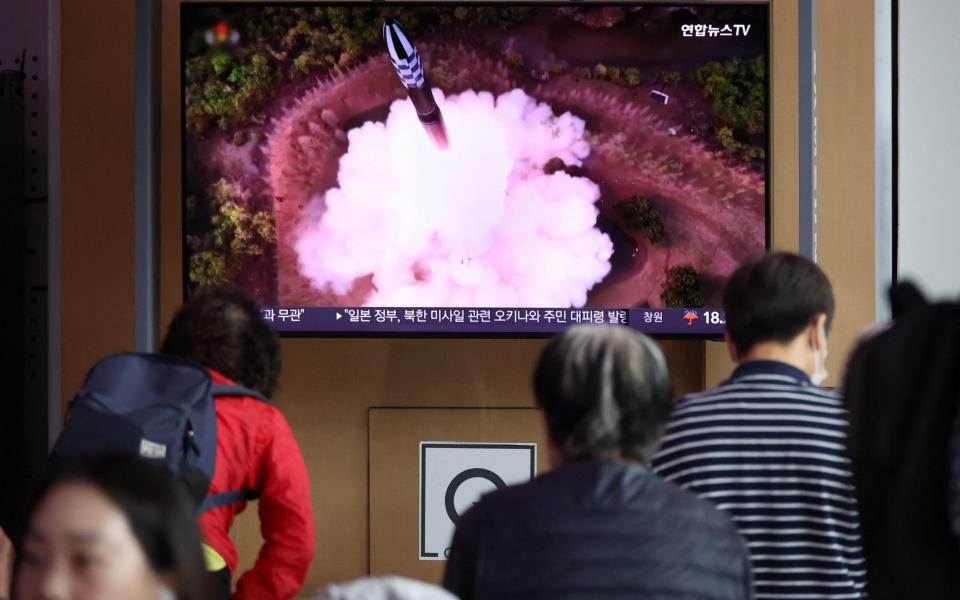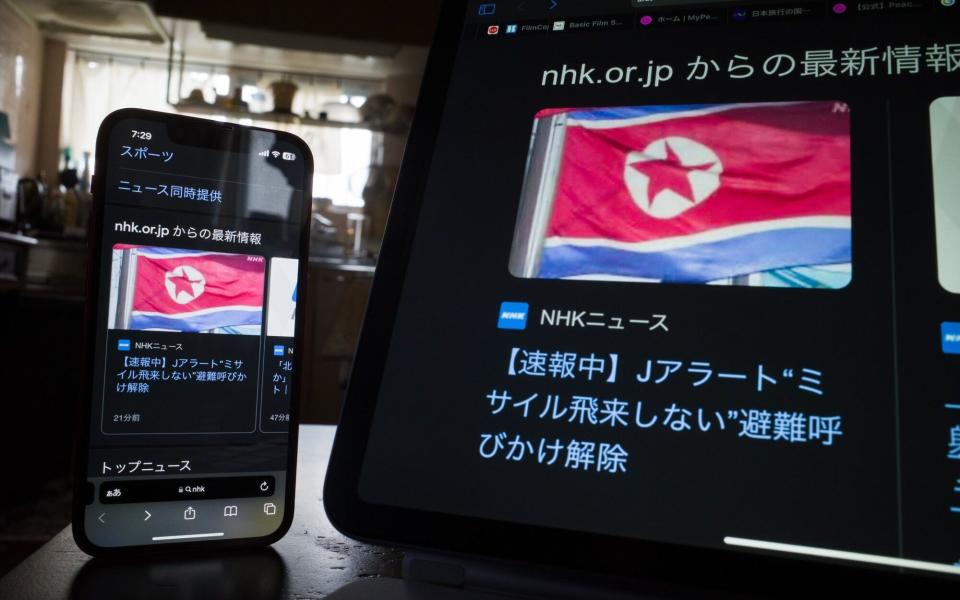Seoul wakes to 'wartime alert' as North Korea fires space launch vehicle

South Korea’s capital woke to the sound of air raid sirens and a “wartime alert” to prepare to potentially evacuate on Wednesday after North Korea claimed to have fired a space launch vehicle towards the south.
The evacuation alert, which was sent out to Seoul residents by text message at 6.32am along with a high-pitched alarm, triggered loudspeaker warnings across the city of 10 million. It was recalled some 21 minutes later as an “error” and the military confirmed there would be no impact on the city.
Air Raid Sirens heard minutes ago in both the City of Seoul, South Korea and on the Japanese Island of Okinawa with both of the Alerts stating that Residents should Shelter-in-Place and await possible orders to Evacuate. pic.twitter.com/CzCWm9LGhZ
— OSINTdefender (@sentdefender) May 30, 2023
Later on Wednesday morning, North Korea said the “Chollima-1” rocket carrying the satellite, named “Malligyong-1” had crashed into the Yellow Sea due to an engine problem and that the regime plans to carry out its second launch “as soon as possible”.
The carrier rocket fell “after losing thrust due to the abnormal starting of the second-stage engine after the separation of the first stage during the normal flight,” said state media outlet KCNA.
Photos of what South Korea says are likely part of the failed North Korean space launch vehicle fired today pic.twitter.com/Jrs0vazVwG
— Josh Smith (@joshjonsmith) May 31, 2023
The failure was attributable to “the low reliability and stability of the new-type engine system and unstable character of the fuel used,” the report said, citing a spokesperson of the state-run space development agency, reported Yonhap.
The White House strongly condemned the launch and said President Joe Biden and his national security team were “assessing the situation in close coordination with our allies and partners”.
The Japanese government also briefly issued an emergency warning over its J-Alert broadcasting system for residents of the southern prefecture of Okinawa, saying a missile had been launched from North Korea. It later confirmed the missile did not fly over Japanese territory and lifted the alert.

The alarms followed outrage in Seoul and Tokyo earlier this week after Pyongyang unveiled a plan to launch its first military spy satellite into orbit. The United States also condemned the move as a violation of UN security council resolutions that ban the country from using ballistic technology.
Analysts warn a military satellite would enhance North Korea’s surveillance capability and improve its ability to strike targets in the event of war, playing a crucial role in the event of a nuclear pre-emptive strike.
The development of military reconnaissance technology has long been one of the North’s stated defence goals. In a statement on state media on Tuesday, Pyongyang’s Central Military Commission indicated the planned launch was a response to ongoing joint US-South Korean military drills.
It said the satellite would allow the North to monitor “military acts of the enemy in real time”.
South Korea’s Joint Chiefs of Staff said they were analysing the situation. The presidential National Security Council was also set to convene to discuss the launch.
Leif-Eric Easley, a professor at Ewha University in Seoul, said the launch took place after Pyongyang accused Seoul and Washington of “raising tensions with scaled-up live fire exercises” and amid its concerns about warming ties between South Korea and Japan.
“Whether or not North Korea’s current satellite mission is a success, Pyongyang can be expected to issue political propaganda about its space capabilities as well as diplomatic rhetoric aimed at driving a wedge between Seoul and Tokyo,” he said.
Erroneous alert not unprecedented
South Korea’s interior minister separately sent out an emergency alert to residents of Baengnyeong Island and Daecheong Island, near the western maritime border separating the two Koreas, advising islanders to evacuate.
“The doors of some 20 shelters were opened up, and many residents took refuge,” local officials told Yonhap.
The erroneous alert in Seoul, which generated no visible panic on the streets, is not unprecedented. False alarms have been issued before during times of heightened tensions with North Korea and when the authorities are scrambling to establish information about missile launches in real time.
Japan’s J-alert system, which transmits warnings when an earthquake or tsunami occurs or a missile threatens to reach or fly over Japanese territory, was falsely triggered last November after wrong information that a North Korean projectile was flying overhead.
The alert urging more than 5 million residents to take immediate shelter shortly before 8am on November 3, but was then withdrawn about 15 minutes later. Pyongyang had tested a missile but it did not enter Japanese airspace.
After a five-month-long enquiry, Japan said it stood by the J-alert system, saying that “safety is our top priority.” Officials explained that in the first moments after a launch, there can be uncertainty about where, precisely, a missile will land.
However, the potential for spreading panic through false alarms was starkly illustrated in Hawaii in 2018, when a mistaken ballistic missile attack alert sounded for more than 30 minutes, after an employee at the state’s Emergency Management System pressed the wrong button.
“BALLISTIC MISSILE THREAT INBOUND TO HAWAII. SEEK IMMEDIATE SHELTER. THIS IS NOT A DRILL,” was sent out in a mass text message, prompting family members to send their goodbyes to each other.
Others sought shelter anywhere they could, including Matt Lopresti, a local politician who said he and his wife grabbed their children, “put them in the bath tub, said our prayers, tried to find out what the hell was going on.”

 Yahoo News
Yahoo News 